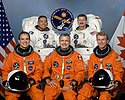STS-97
 | |
| Dane misji | |
| Indeks COSPAR | 2000-078A |
|---|---|
| Zaangażowani | |
| Oznaczenie kodowe | STS-97 |
| Pojazd | |
| Wahadłowiec | Endeavour |
| Załoga | |
 Od lewej: Michael J. Bloomfield, Carlos I. Noriega, Marc Garneau, Joseph R. Tanner, Brent W. Jett | |
| Dowódca | Brent Jett |
| Start | |
| Miejsce startu | Stany Zjednoczone, KSC, LC39-B |
| Początek misji | 1 grudnia 2000 03:06:01 UTC |
| Orbita okołoziemska | |
| Apogeum | 365 km |
| Perygeum | 352 km |
| Okres orbitalny | 91,7 min |
| Inklinacja orbity | 51,6° |
| Lądowanie | |
| Miejsce lądowania | KSC, pas startowy 15 |
| Lądowanie | 11 grudnia 2000 23:03:23 UTC[1] |
| Czas trwania misji | 10 dni, 19 godzin, 57 minut i 22 sekundy[1] |
| Przebyta odległość | 4,476 mln km |
| Liczba okrążeń Ziemi | 170[2] |
| Program lotów wahadłowców | |
STS-97 (ang. Space Transportation System) – misja wahadłowca Endeavour amerykańskiej agencji rządowej NASA do Międzynarodowej Stacji Kosmicznej. Była to piętnasta misja wahadłowca Endeavour i sto pierwsza programu lotów wahadłowców[3].
Załoga
- Brent W. Jett (3)* – dowódca misji
- Michael Bloomfield (2) – pilot
- Joseph R. Tanner (3) – specjalista misji 1
- Carlos Noriega (2) – specjalista misji 3
- Marc Garneau (3) – specjalista misji 2 (CSA Kanada)
- *(w nawiasie podano liczbę lotów odbytych przez każdego z astronautów)
Parametry misji
- Masa:
- startowa orbitera: 120 742 kg
- lądującego orbitera: 89 758 kg
- ładunku: 18 740 kg[5]
- Perygeum: 352 km[5]
- Apogeum: 365 km[5]
- Inklinacja: 51,6°[5]
- Okres orbitalny: 91,7 min[5]
Dokowanie do ISS
- Połączenie z ISS: 2 grudnia 2000, 19:59:49 UTC
- Odłączenie od ISS: 9 grudnia 2000, 19:13:00 UTC
- Łączny czas dokowania: 6 dni 23 godzin 13 minut 11 sekund
Spacery kosmiczne
- J. Tanner i C. Noriega – EVA 1
- Początek EVA 1: 3 grudnia 2000 – 18:35 UTC
- Koniec EVA 1: 4 grudnia – 02:08 UTC
- Łączny czas trwania: 7 godzin 33 minuty
- J. Tanner i C. Noriega – EVA 2
- Początek EVA 2: 5 grudnia 2000 – 17:21 UTC
- Koniec EVA 2: 5 grudnia – 23:58 UTC
- Łączny czas trwania: 6 godzin 37 minut
- J. Tanner i C. Noriega – EVA 3
- Początek EVA 3: 7 grudnia 2000 – 16:13 UTC
- Koniec EVA 3: 7 grudnia – 21:23 UTC
- Łączny czas trwania: 5 godzin 10 minut
Cel misji
Szósty lot wahadłowca na stację kosmiczną ISS – dostarczenie pierwszego panelu baterii słonecznych do segmentu P6 kratownicy ITS[3].
Zobacz też
Przypisy
- ↑ a b Adam Chen, William Wallack, George Gonzales: Celebrating 30 Years of the Space Shuttle program. NASA, 2012. ISBN 978-0-16-090202-4.
- ↑ podsumowanie misji STS-97 na stronie KSC (ang.)
- ↑ a b c Tomáš Přibyl: Dzień, w którym nie wróciła COLUMBIA. Debit, Czerwiec 2003. ISBN 83-7167-224-1.
- ↑ Robert Godwin: Space Shuttle. Warszawa: Prószyński Media Sp. z o.o., 2011, s. 83, seria: Historia podboju Kosmosu. ISBN 978-83-7648-973-5.
- ↑ a b c d e Mark Wade: STS-97 (ang.). W: Encyclopedia Astronautica [on-line]. [dostęp 2017-07-27].
Linki zewnętrzne
- podsumowanie misji STS-97 na stronie KSC (ang.)
- Mark Wade: STS-97 (ang.). W: Encyclopedia Astronautica [on-line]. [dostęp 2017-07-27].
- Spaceflight mission report: STS-97 (ang.). Spacefacts. [dostęp 2017-07-27].
Media użyte na tej stronie
The flag of Navassa Island is simply the United States flag. It does not have a "local" flag or "unofficial" flag; it is an uninhabited island. The version with a profile view was based on Flags of the World and as a fictional design has no status warranting a place on any Wiki. It was made up by a random person with no connection to the island, it has never flown on the island, and it has never received any sort of recognition or validation by any authority. The person quoted on that page has no authority to bestow a flag, "unofficial" or otherwise, on the island.
These five astronauts are in training for the STS-97 mission, scheduled to be launched late next year aboard the Space Shuttle Endeavour for a working visit to the International Space Station (ISS). Astronaut Brent W. Jett (front right) and Michael J. Bloomfield (front left) are commander and pilot, respectively. Flanked by those two is astronaut Marc Garneau, mission specialist representing the Canadian Space Agency (CSA). In the rear are astronauts Carlos I. Noriega (left) and Joseph R. Tanner, both mission specialists. Noriega and Tanner are wearing training versions of the extravehicular mobility unit (EMU) spacesuits they'll be wearing for spacewalking chores during the flight.
This is the crew insignia for STS-97, which will deliver, assemble, and activate the U.S. electrical power system on board the International Space Station (ISS). The electrical power system, which is built into a 47-foot integrated truss structure known as P6, consists of solar arrays, radiators, batteries, and electronics. P6 will be attached to the Station using the Shuttle's robotic arm in coordination with spacewalking crewmembers that will make the final connections. The spacewalkers will then prepare P6 for the subsequent deployments of the large solar arrays and radiator, which are critical steps in the activation of the electrical power system. The 120-foot solar arrays will provide the power necessary for the first ISS crews to live and work in the U.S. segment.
The crew patch depicts the Space Shuttle docked to ISS in low Earth orbit after the activation of the P6 electrical power system. Gold and silver are used to highlight the portion of ISS that will be installed by the STS-97 crew. The Sun, central to the design, is the source of energy for ISS.




